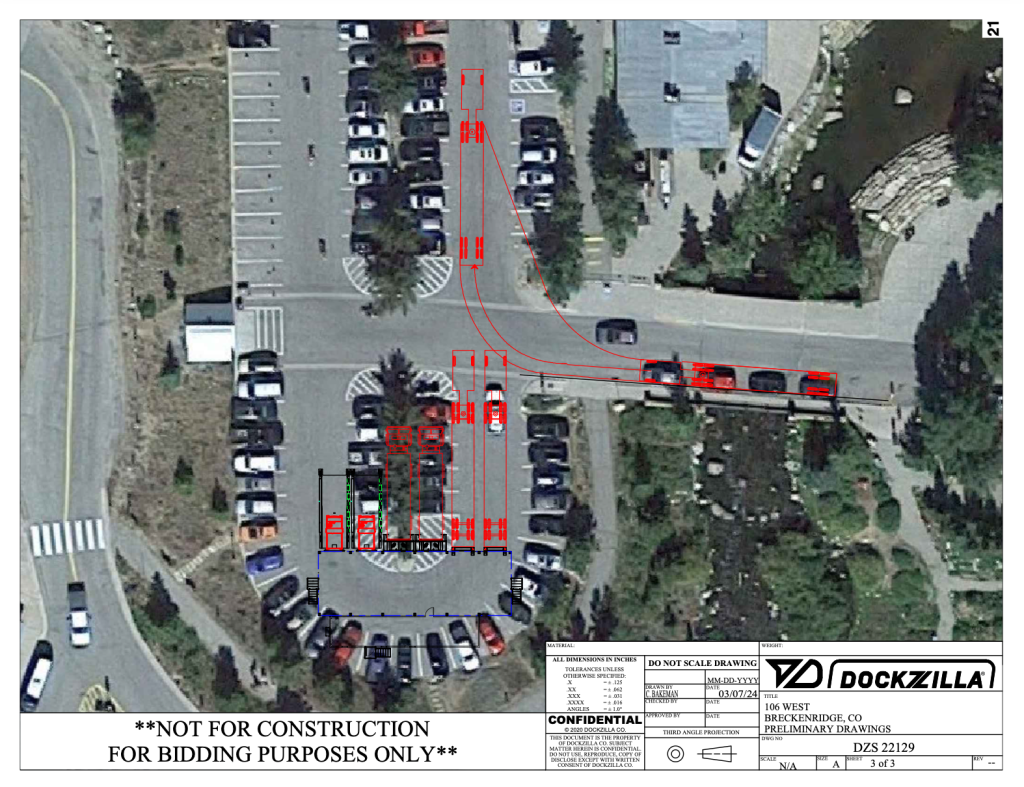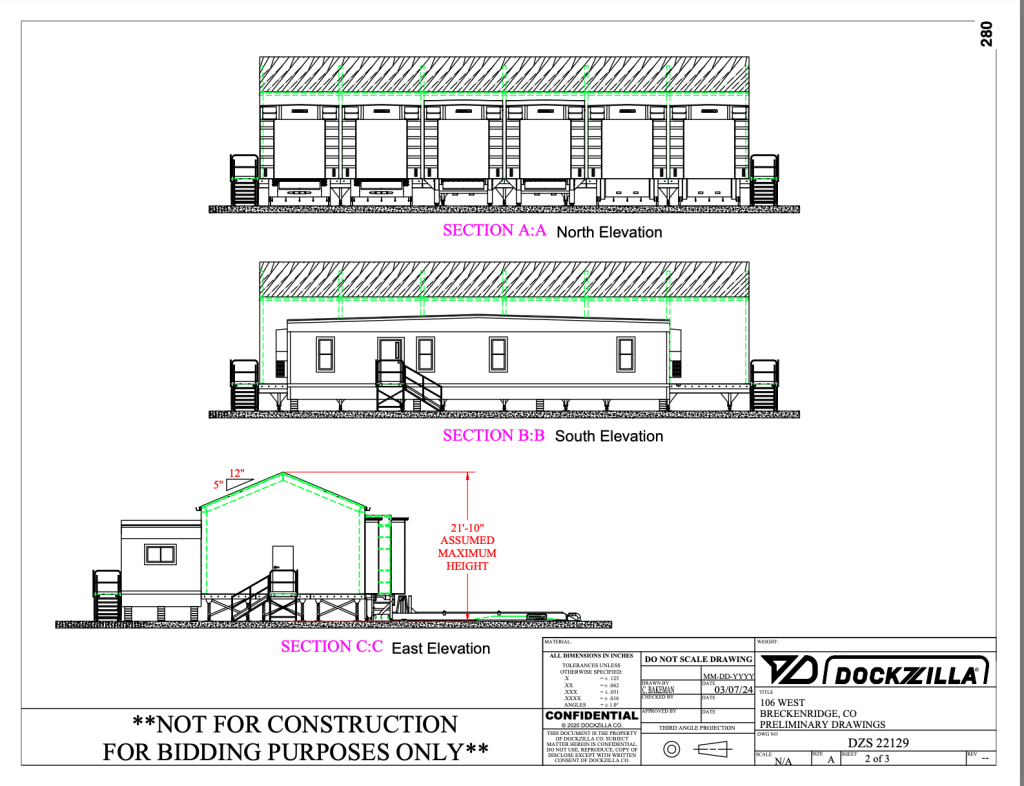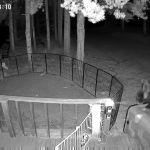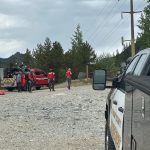Concerns ease as Breckenridge plans to turn a downtown parking lot into a delivery hub to help reduce congestion

Kit Geary/Summit Daily News
After eyeing Vail’s new food and beverage delivery system for several months, the town of Breckenridge is planning a pilot program with the same contractor.
Breckenridge Town Council on March 26 approved a temporary structure and office for a food and beverage delivery service that is planned to operate out of the Tiger Dredge parking lot downtown. The plan is to have this center operate from around 5 a.m. to 10 a.m. for a pilot program that is slated to last two years. Much of the operations will be handled by the contractors 106 West Logistics and Dockzilla.
Instead of having delivery trucks make stops throughout downtown, there would be a central delivery center where everything is dropped off and then dispersed through a small fleet of electric vehicles. If the town ends up fully implementing this program, it is estimated to eliminate around 150 truck trips from Breckenridge’s core each week.
Now that Town Council approved the project, town staff say preparation and grading for the center will begin in June, construction will happen in July and the delivery service should start in August.
The town anticipates it will cost around $2 million.
Town Engineer Shannon Smith told the Planning Commission at a March 19 meeting that the pilot is anticipated to start with six vendors, but the hope is to get that number up to around 30 vendors. The goal is to have up to 70 businesses participate in the pilot.
Between the two temporary structures, the center will take up 2,386 square feet of the southern horseshoe part of the Tiger Dredge Lot.
Staff say the project is ultimately meant to support the town’s Blue River Pathways Project that has the goal of getting “more boots” on the ground and “less cars” on the roads. This not only aims to ease congestion to improve pedestrian and bicycle safety but also to reduce emissions by having fewer trucks.

In October 2022 Vail launched its delivery service program, and town officials estimated that it eliminated 125-150 delivery truck trips in the town’s pedestrian village each week.
While the success Vail had with its program prompted Breckenridge to follow suit, it also prompted a lawsuit. High-volume commercial carriers such as UPS, FedEx, and DHL filed a lawsuit against the town for an ordinance it passed banning delivery vehicles and trucks in its villages to support this program claiming it was anticompetitive and preemptive by law.
On Dec. 15 a federal judge issued a preliminary injunction prohibiting the town from enforcing the ordinance until a trial is held, and the town filed an appeal on Jan. 11. A trial date has yet to be set.
Breckenridge officials have previously expressed the town has no plans to enforce a similar ban for its pilot program and will adhere to whatever the court requires in the Vail lawsuit.
Lingering questions and concerns
While both town council and planning commission gave unanimous approval for this project, there were a handful of concerns about the program’s location and how it will function.
Both the Breckenridge Planning Commission and Town Council raised concerns about the program taking up 2,386 square feet of a lot that is in the center of town. Business owners were wary that it would remove 36 existing employee parking spaces within the southern horseshoe part of the Tiger Dredge Lot and approximately 8 parking spaces from West Adams Avenue.

Planner Sarah Crump assured them that the town plans to make accommodations and move the employee parking spots that would be lost to a different town lot, which helped ease some concern.
Both groups wondered if there was another location that the program could be based. Staff said they considered eight different spots in town, but officials determined that the Tiger Dredge Lot was by far the best fit.
“It’s really a function of time and motion, and having it any further out on the periphery of town, from a logistics and kind of an operational perspective, would add more people, more vehicles,” public works director James Phelps told town council at their March 26 meeting, noting the efficiency would not be the same in different locations.
He said that if the town ended up wanting to permanently implement this program, there are talks of expanding F Lot to potentially have the center there. He said it is also possible for the facility to be partially underground, or at least at garden level, to avoid taking up too much space.
Planning commissioner Allen Fletcher pointed out at the March 19 meeting that a temporary Sprung structure in this area could be a conflict of interest considering for the Town Council.
“I know the Town Council is concerned about any Sprung structures up on the base of Peak 8 during the BGV project,” Fletcher said, referencing the East Peak 8/Gold Rush Lot development. “But now we have a two-year sprung structure here. So it seems a little bit of a conflict.”
Since the Tiger Dredge parking lot is downtown, both groups had questions about traffic circulation.
The plan calls for a vehicular entrance and exit for large commercial delivery vehicles via West Adams Avenue. The larger delivery vehicles, greater than 35 feet in length, will be required to travel south down Main Street and turn right on West Adams Avenue to enter the site. Smaller trucks will come down Park Avenue and use the roundabout to get to the lot from that side.
Town engineer Shannon Smith told the planning commission that this should not impact traffic circulation drastically since the plan mimics the typical moment of large delivery trucks throughout town.
Council member Jay Beckerman questioned staff about how many trucks would be using this entrance per day under the pilot program, to which Phelps replied that has yet to be determined.
The planning commission had some questions about pricing after seeing the approximately $2-million price tag. Smith fielded these questions and stressed the importance of this project to the community.
“It will get about $60,000 a year in revenue, versus the million dollars in operating expenses,” Smith said. “So this isn’t a project to make money, its a project to improve safety.”
Restaurateur Terry Barbu, owner of spots such as BoLD and Blue Stag Saloon in Breckenridge, made a public comment at the March 26 meeting, raising both questions and concerns about how this would impact restaurants.
He said he was worried about how the program would impact his restaurants’ relationships with vendors, something he said is extremely valuable and took some time to form. He also expressed concern about how the system would operate in the wintertime, fearing that the electric delivery vehicles would freeze in the cold.
As a long-time restaurant owner, Barbu also said he is no stranger to dealing with deliveries going wrong coming up from Denver during the winter and having to scramble to get inventory. He wondered where accountability would fall when weather impacts the delivery process.
“When something doesn’t show up, who do we call, how do we go after to try to figure out where it is?” Barbu asked.
“I want to have the ability to work with the vendor that you’re using so they can figure out ways that we can feel comfortable with this and not be stuck in the dark as to where our product is,” Barbu added.
Council member Dick Carleton, also a business owner, offered that it might be helpful for Barbu to get a tour of Vail’s delivery center to see how it works logistically and talk to business owners over there. He said he shared the same concerns at first and a tour helped alleviate those.
The rest of the council agreed and said it would be helpful for numerous restaurants to get this tour and meet with the contractor.
Overall council felt there was value in giving this program a go as a pilot.
“I think we all realize how important the food and beverage industry is to our community. … We want to make this with hope to make it easier to function in our community,” Council member Jeffrey Bergeron said.
Mayor pro tem Kelly Owens had a similar sentiment and said, after hearing the feedback from restaurants in Vail about how this improved the delivery process and the pedestrian villages, she felt it was the right move.

Support Local Journalism

Support Local Journalism
As a Summit Daily News reader, you make our work possible.
Summit Daily is embarking on a multiyear project to digitize its archives going back to 1989 and make them available to the public in partnership with the Colorado Historic Newspapers Collection. The full project is expected to cost about $165,000. All donations made in 2023 will go directly toward this project.
Every contribution, no matter the size, will make a difference.










